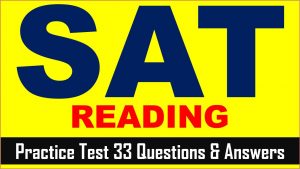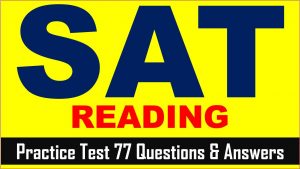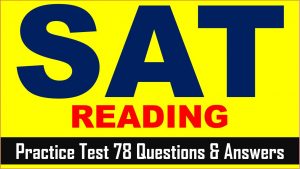SAT (Scholastic Assessment Test) is a standard test, used for taking admission to undergraduate programs of universities or colleges of the United States. SAT is developed and published by the College Board, an organization in the United States, administered by the Educational Testing Service. In this article of AKVTutorials, you will get Kaplan SAT Test Course Book Review | Practice Test 12 AMBiPi.
Kaplan SAT Test Course Book Review
Are you SAT Exam 2024 aspirant and want to start your preparation from book SAT Prep Plus 2024 Kaplan?
If yes, then first you must to know about Kaplan Book.
How to start your SAT preparation from Kaplan and how to read this book.
Let’s start to know full details of Kaplan SAT Guidance Book.
Kaplan is a publishing company, in New York, that clearly declared that SAT is a registered and owned by College Board and this Kaplan SAT Book is not endorsed by College Board.
In this book, the authors and reviewers share their guidance of clearing SAT exam 2024.
The authors and reviewer of Kaplan SAT book are Micheal Cook, Christopher Cosci, Boris Dvorkin, John Evans, Jack Hayes, Rebecca Knauer, Jo L’Abbate, Bird Marathe, Karen McCulloch, Melissa McLaughlin, Gail Rivers, Anne Marie Salloum, Jason Selzer, Gordon Spector, Carline Sykes, Bob Verini, MFA, Bonnie Wang and Ethan Weber.
These authors provide accurate information in regard to the subject matter covered as of its publication data, with the understanding that knowledge and best practice constantly evolve.
According to these authors of Kaplan SAT preparation book, any aspirant can get a great SAT score from active engagement of this book. Kaplan provides a direction, focus your SAT preparation and teaches you specific skills that is required to crack SAT exam 2024.
In this Kaplan book for SAT, practice tests are just like actual SAT exam. By practicing these tests, you will prepare yourself for the actual test day experience.
Every chapter in Kaplan start with “How Much Do You Know”, where a typical question is asked related to SAT exam syllabus and at the end of the chapters a practice set is given and hence you check “How Much Have You Learned”.
Apart from SAT practice test, this book has
- How to Maximize Your Score
- Where and When to Take SAT Exam
- Triaging SAT Test
- Elimination
- Strategic Guessing
Kaplan SAT Prep Plus Book Table of Contents
Check Price On Amazon
Part 1: The SAT and You
Chapter 1: Inside the SAT
- SAT Structure
Part 2: SAT Math
Chapter 2: Prerequisite Skills and Calculator Use
- Math Fundamentals
- Calculator Use
Chapter 3: The Method for SAT Math Questions
- How to Do SAT Math
- A Note About Grid-ins
- Next Steps
Part 2A: The Heart of Algebra
Chapter 4: Linear Equations and Graphs
- How Much Do You Know?
- Solving Equations
- Word Problems
- Linear Graphs
- On Test Day
- How Much Have You Learned?
- Next Step
Chapter 5: System of Linear Equation
- How Much Do You Know?
- Substitutions
- Combination
- Number of Possible Solutions
- On Test Day
- How Much Have You Learned?
- Next Step
Chapter 6: Inequalities
- How Much Do You Know?
- Linear Inequalities
- System of Inequalities
- Modelling Real-Life Situation with Inequalities
- On Test Day
- How Much Have You Learned?
- Next Step
Part 2B: Data Analysis
Chapter 7: Ratios, Proportions, and Percent
- How Much Do You Know?
- Ratio and Proportions
- Unit Conversion
- Percent
- Percent Change
- On Test Day
- How Much Have You Learned?
- Next Step
Chapter 8: Tables, Statistics and Probability
- How Much Do You Know?
- Tables and Graphs
- Statistics
- Surveys and Data Samples
- Probability
- On Test Day
- How Much Have You Learned?
- Next Step
Chapter 9: Scatterplot
- How Much Do You Know?
- Line of Best Fit
- Scatter Plot modelling
- On Test Day
- How Much Have You Learned?
- Next Step
Part 2C: Passport to Advance Math
Chapter 10: Functions
- How Much Do You Know?
- Function Notation
- Graph of Functions
- Describing Real Life Situation with Functions
- On Test Day
- How Much Have You Learned?
- Next Step
Chapter 11: Exponents, Radicals, Polynomials and Rational Expressions
- How Much Do You Know?
- Exponents
- Radicals
- Polynomials
- Polynomial Division
- Graph of Polynomial Functions
- Modelling Growth and Decay
- Rational Expression and Equations
- On Test Day
- How Much Have You Learned?
- Next Step
Chapter 12: Quadratics
- How Much Do You Know?
- Solving Quadratics by Factoring
- Classic Quadratics
- Completing the Squares
- The Quadratic Formulas
- Graph of Quadratics
- System of Quadratic and Linear Equations
- On Test Day
- How Much Have You Learned?
- Next Step
Part 2D: Other Topics in Math
Chapter 13: Geometry
- How Much Do You Know?
- Similar Triangles
- Pythagorean Theorem
- Special Right Triangles
- Circles
- Arc Lengths and Sectors
- Three-Dimensional Figures
- On Test Day
- How Much Have You Learned?
- Next Step
Chapter 14: Trigonometry
- How Much Do You Know?
- Sine, Cosine, and Tangent
- On Test Day
- How Much Have You Learned?
- Next Step
Chapter 15: Imaginary Numbers
- How Much Do You Know?
- Arithmetic Operations with Complex Numbers
- On Test Day
- How Much Have You Learned?
- Next Step
Chapter 16: SAT Math: Timing and Section Management Strategies
- SAT Math Timing and Triage
Part 3: SAT Reading
Chapter 17: The Method for SAT Reading Questions
- How To Do SAT Reading
- How Much Have You Learned?
- Next Step
Chapter 18: SAT Reading Passage Strategies
- How Much Do You Know?
- SAT Reading Strategies- Keywords, Margin Notes, and Big Picture Summary
- How Much Have You Learned?
- Next Step
Chapter 19: SAT Reading Questions Types
- How Much Do You Know?
- How To Unpack SAT Reading Questions Stems
- How Much Have You Learned?
- Next Step
Chapter 20: Answering SAT Reading Questions
- How Much Do You Know?
- How To Answer SAT Reading Questions
- How Much Have You Learned?
- Next Step
Chapter 21: Paired Passage and Primary Source Passages
- How Much Do You Know?
- How To Approach SAT Paired Passage and Primary Sources
- How Much Have You Learned?
- Next Step
Chapter 22: Literature Passages
- How Much Do You Know?
- How To Read Literature for the SAT
- How Much Have You Learned?
- Next Step
Chapter 23: SAT Reading: Timing and Section Management Strategies
- Timing
- Section Management
- How Much Have You Learned?
Part 4: SAT Writing and Language
Chapter 24: The Method for SAT Writing and Language Questions
- How To Do SAT Writing and Language
Chapter 25: Spotting and Fixing Errors: Sentence Structure, Punctuation, and Agreement
- How Much Do You Know?
- Sentence Structure: The Basic
- Sentence Structure: Commas, Dashes and Colons
- Agreement: Verbs
- Agreement: Pronouns
- Agreement: Modifiers
- Idioms
- How Much Have You Learned?
- Next Step
Chapter 26: Spotting and Fixing Errors: Organization, Development and Graphs
- How Much Do You Know?
- Organization: Conciseness
- Organization: Transition
- Organization: Sentence Placement
- Development: Precision
- Development: Relevance
- Development: Revising Text
- Introduction and Conclusions
- Graphs
- How Much Have You Learned?
- Next Step
Chapter 27: SAT Writing and Language: Timing and Section Management
- Strategies
- Timing
- Section Management
- How Much Have You Learned?
Part 5: SAT Essay
Chapter 28: The Method for SAT Essay Questions
- Should I Write the SAT Essay
- Essay Essential
- Dissecting the Prompt
- What The Grades Want
- How Much Have You Learned?
- Part 6: Countdown to Test Day
Chapter 29: Countdown to Test Day
Part 7: Practice Tests
Check Price On Amazon
SAT Reading Practice Passage
This passage is adapted from Taras Grescoe, Straphanger: Saving Our Cities and Ourselves from the Automobile. ©2012 by Taras Grescoe.
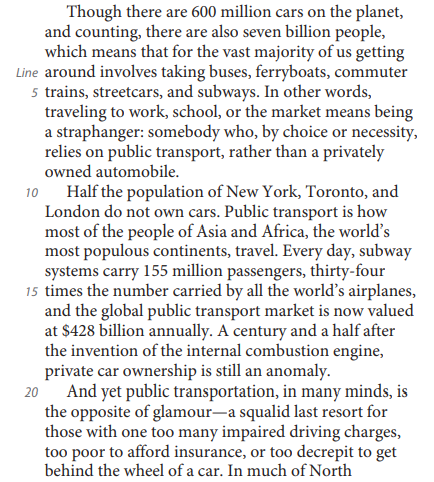
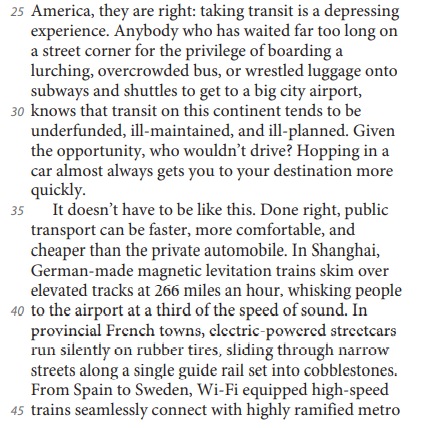
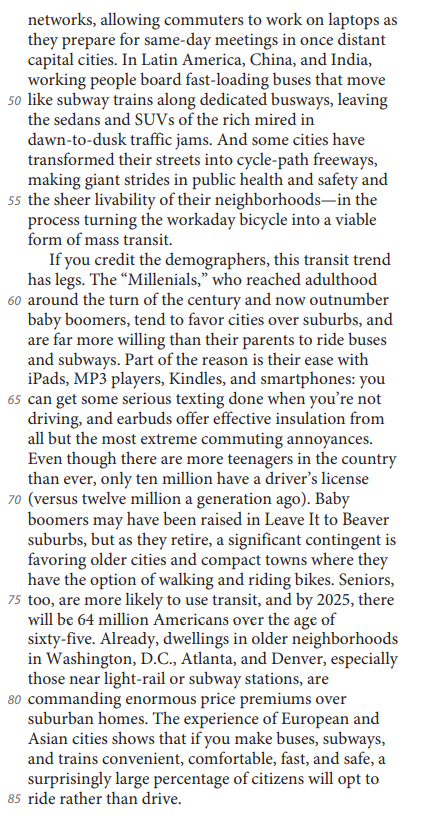
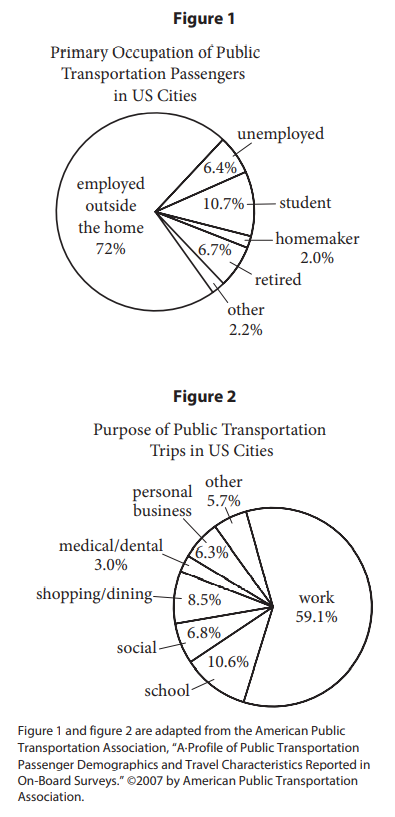
SAT Reading Comprehension Practice Test Questions
Check On Amazon
SAT Practice Test 12 Question No 1
What function does the third paragraph (lines 20-34) serve in the passage as a whole?
Option A: It acknowledges that a practice favored by the author of the passage has some limitations.
Option B: It illustrates with detail the arguments made in the first two paragraphs of the passage.
Option C: It gives an overview of a problem that has not been sufficiently addressed by the experts mentioned in the passage.
Option D: It advocates for abandoning a practice for which the passage as a whole provides mostly favorable data.
SAT Practice Test 12 Answer No 1
Show/Hide Answer
Option A :
While the author predominantly supports the use of public transportation, in the third paragraph he recognizes some limitations to the public transportation system: it is a “depressing experience” (lines 25-26) and “underfunded, ill-maintained, and ill-planned” (line 31).
Choices B, C, and D are incorrect because the third paragraph does not expand upon an argument made in the first two paragraphs, provide an overview of a problem, or advocate ending the use of public transportation.
SAT Practice Test 12 Question No 2
Which choice does the author explicitly cite as an advantage of automobile travel in North America?
Option A: Environmental impact
Option B: Convenience
Option C: Speed
Option D: Cost
SAT Practice Test 12 Answer No 2
Show/Hide Answer
Option C :
The author notes that in North America “hopping in a car almost always gets you to your destination more quickly” (lines 32-34). This statement suggests that speed is one advantage to driving in North America.
Choices A, B, and D are incorrect because the author does not cite environmental impact, convenience, or cost as advantages of driving in North America.
SAT Practice Test 12 Question No 3
Which choice provides the best evidence for the answer to the previous question?
Option A: Lines 5-9 (“In… automobile”)
Option B: Lines 20-24 (“And… car”)
Option C: Lines 24-26 (“In… the experience”)
Option D: Lines 32-34 (“Hopping… quickly”)
SAT Practice Test 12 Answer No 3
Show/Hide Answer
Option D :
In lines 32-34, the author provides evidence that speed is one advantage to driving in North America because driving “almost always gets you to your destination more quickly.”
Choices A, B, and C do not provide the best evidence that speed is one advantage to driving in North America. Choices A and B are incorrect because they offer general information about using public transportation. Choice C is incorrect because although these lines mention North America, they focus on the disadvantages of public transportation.
SAT Practice Test 12 Question No 4
The central idea of the fourth paragraph (lines 35-57) is that
Option A: European countries excel at public transportation.
Option B: some public transportation systems are superior to travel by private automobile.
Option C: Americans should mimic foreign public transportation systems when possible.
Option D: much international public transportation is engineered for passengers to work while onboard.
SAT Practice Test 12 Answer No 4
Show/Hide Answer
Option B :
The author argues in the fourth paragraph that public transportation “can be faster, more comfortable, and cheaper than the private automobile” (lines 36-37) and provides examples of fast and convenient public transportation systems.
Choices A, C, and D are incorrect because they focus on points made in the fourth paragraph rather than the paragraph’s central idea.
SAT Practice Test 12 Question No 5
Which choice provides the best evidence for the answer to the previous question?
Option A: Line 35 (“It… this”)
Option B: Lines 35-37 (“Done… automobile”)
Option C: Lines 37-40 (“In… sound”)
Option D: Lines 44-48 (“From… cities”)
SAT Practice Test 12 Answer No 5
Show/Hide Answer
Option B :
In lines 35-37, the author provides evidence that some public transportation systems are superior to driving because public transportation “can be faster, more comfortable, and cheaper than the private automobile.
Choices A, C, and D do not provide the best evidence that some public transportation systems are superior to driving, as they highlight points made in the fourth paragraph rather than the paragraph’s central idea.
SAT Practice Test 12 Question No 6
As used in line 58, “credit” most nearly means
Option A: endow.
Option B: attribute.
Option C: believe.
Option D: honor.
SAT Practice Test 12 Answer No 6
Show/Hide Answer
Option C :
In the last paragraph, the author explains the trend that people who became adults around the end of the twentieth century are more willing to use public transportation than people from older generations. The author notes, “If you credit the demographers, this transit trend has legs” (lines 58-59). In this context, “credit” means to believe the demographers’ claims about the trend.
Choices A, B, and D are incorrect because in this context, “credit” does not mean endow, attribute, or honor.
SAT Practice Test 12 Question No 7
As used in line 61, “favor” most nearly means
Option A: indulge.
Option B: prefer.
Option C: resemble.
Option D: serve.
SAT Practice Test 12 Answer No 7
Show/Hide Answer
Option B :
In lines 59-63, the author explains the trend of people who became adults around the end of the twentieth century “tend[ing] to favor cities over suburbs.” In this context, these adults “favor,” or prefer, cities over suburbs.
Choices A, C, and D are incorrect because in this context “favor” does not mean indulge, resemble, or serve.
SAT Practice Test 12 Question No 8
Which choice best supports the conclusion that public transportation is compatible with the use of personal electronic devices?
Option A: Lines 59-63 (“The… subways”)
Option B: Lines 63-67 (“Part… annoyances”)
Option C: Lines 68-70 (“Even… ago”)
Option D: Lines 77-81 (“Already… homes”)
SAT Practice Test 1 Answer No 8
Show/Hide Answer
Option B :
In lines 63-67, the author explains that while riding on public transportation, people can use personal electronic devices, such as “iPads, MP3 players, Kindles, and smartphones.
Choices A, C, and D are incorrect because they do not show that public transportation is compatible with the use of personal electronic devices.
SAT Practice Test 12 Question No 9
Which choice is supported by the data in the first figure?
Option A: The number of students using public transportation is greater than the number of retirees using public transportation.
Option B: The number of employed people using public transportation and the number of unemployed people using public transportation are roughly the same.
Option C: People employed outside the home are less likely to use public transportation than are homemakers.
Option D: Unemployed people use public transportation less often than do people employed outside the home.
SAT Practice Test 12 Answer No 9
Show/Hide Answer
Option A :
Figure 1 shows that 10.7% of public transportation passengers are students and 6.7% of public transportation passengers are retirees. Thus, more students than retirees use public transportation.
Choices B and C are incorrect because figure 1 shows that more employed than unemployed people use public transportation and that more employed people than homemakers use public transportation. Choice D is incorrect because figure 1 does not explain how frequently passengers use public transportation; it only identifies public transportation passengers by their primary occupation.
SAT Practice Test 12 Question No 10
Taken together, the two figures suggest that most people who use public transportation
Option A: are employed outside the home and take public transportation to work.
Option B: are employed outside the home but take public transportation primarily to run errands.
Option C: use public transportation during the week but use their private cars on weekends.
Option D: use public transportation only until they can afford to buy a car.
SAT Practice Test 12 Answer No 10
Show/Hide Answer
Option A :
Figure 1 shows that 72% of public transportation passengers are “employed outside the home,” and figure 2 indicates that 59.1% of public transportation trips are for “work.” It can be inferred from these figures that many public transportation passengers take public transportation to their place of employment.
Choices B, C, and D are incorrect because figures 1 and figure 2 do not indicate that public transportation passengers primarily use the system to run errands, use their car on weekends, or are planning to purchase a car.



